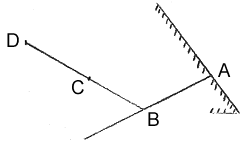
| Key | |
| A | Entrance to Great Pyramid |
| B | Junction of Ascending Passage (BC) and Descending Passage (AB produced) |
| C | End of Ascending Passage (BC) and entry to Great Gallery (CD) |
| D | Head of Great Gallery |
We cannot definitely ‘disprove’ many pyramid theories. The sceptic can assert that a particular theory rests upon the mistaken belief that certain numerical coincidences have been invested with a significance that in reality they do not possess, but he cannot disprove the theory, because those numerical coincidences are facts. (There are occasions, of course, where the numerical coincidence has been based on erroneous measurements. But in many cases, the numerical coincidences survive all ‘refinements of measurement’.)
If one cannot ‘disprove’ a particular theory because of the coincidences upon which it rests, we can at least ‘weaken’ its case by doing one of the following:
Each of these might be termed setting up a control experiment for the theory in question.
The sceptic would say that each Great Pyramid theory acts as a control experiment to the others. That is, the diversity of mathematical theories concerning the Great Pyramid establishes the mutual weakening by (a) – rather like the seventeen different ‘true’ authors of the Shakespeare plays, discussed elsewhere. Most sceptics, however, go no further than their own convictions, and there appear to have been very few attempts at proper control experiments.
To be more specific as regards (a), (b) and (c):
Taking as an example the Bible Chronology Theory, can one, by measuring the various lengths of the Great Pyramid Passages and Chambers in units other than ‘pyramid inches’ (say in decimetres) use the pyramid passage system to symbolise, shall we say, a history of the Industrial Revolution? If we can show this, or something similar, then we have either shown that the pyramid was intended to so symbolise Man’s industrial progress, or we have shown that it is comparatively easy to make the pyramid passage system symbolise, chronologically, more or less anything we please – whether that be the Industrial Revolution or some other chosen theme – like Bible Chronology, for instance.
Again, if we can take, say, the pyramid of either Chephren or Mycerinus, or any other pharaoh for that matter, and demonstrate its affinity with, say, Venus or Neptune, then either we have shown that a hitherto unsuspected proportion of Egyptian Pharaohs had extra-terrestrial connections, or we have shown that it is comparatively easy to link more or less any pyramid with some planet in the solar system.
Finally, if we can find, let us say, universal constants such as π or e, or astronomical commensurabilities, such as the eccentricity of the Earth’s orbit, or the radius of the moon, etc., in a modern structure such as, for example, Guildford Town Hall, then we have either shown that the architect of that building had a keen, perhaps subconscious, interest in cosmic architecture, or we have shown that any building, somewhere or other in its structure, will yield up to the patient investigator, unintended and fortuitous numerical coincidences. (The adjective ‘patient’ in the last sentence probably explains why so few attempts have been made by sceptics to set up control experiments. It can be time-consuming work merely to produce isolated results, let alone a consistently related set of them.)
The following observations may be of interest towards setting up control experiments similar to the above types, though they do not pretend to be complete in any way. They are isolated results, but they are a start towards setting up complete control experiments. I hope at a later stage of the folio to expand on them, and I invite other contributors to add any of their own observations along these lines.
Robert Forrest. Sept. 1976.
(1) The Bible Chronology ‘control’ is of type (a).
(2) The Stuart Greenwood ‘control’ of type (c) – except that the ‘computer model’ is provided either by accidental geography or the sky.
(3) The M. W. Saunders Control is of type (b), using Chephren’s Pyramid at Giza.
(4) The J. W. L. Ivimy ‘control’ is of type (c) rather like (2).
For a numerological ‘control’ regarding the so-called ‘5-ness’ of the Great Pyramid see Gardner’s Fads and Fallacies, Dover Edition p. 179. Here he discusses the ‘fiveness’ of the Washington Monument.
Any simulation of the Bible Chronology Theory will have to incorporate the basic passage lengths, of which three are employed here.

| Key | |
| A | Entrance to Great Pyramid |
| B | Junction of Ascending Passage (BC) and Descending Passage (AB produced) |
| C | End of Ascending Passage (BC) and entry to Great Gallery (CD) |
| D | Head of Great Gallery |
| Length of | AB | BC | CD |
| In inches1 | 1110.6 | 1546.5 | 1815.5 |
| In decimetres2 | 282 | 393 | 461 |
| In decayards2 | 3.085 | 4.296 | 5.043 |
Here are two sample ‘chronologies’ using the above lengths.
| (a) On a scale of 1 decimetre to a year | |||
| A | represents AD 411 | – Roman legions leave Britain | |
| B | represents AD 693 | – Saracens’ destruction of Carthage | |
| C | represents AD 1086 | – Completion of Domesday Book | |
| D | represents AD 1547 | – Edward VI King of England | |
| (b) On a scale of 1 decayard to a year | |||
| A | represents June 22nd 1911 | – Coronation of George V and Queen Mary | |
| B | represents Aug 1st 1914 | – Germany declares war against Russia | |
| C | represents Nov 11th 1918 | – Great War ends | |
| D | represents Nov 23rd 1923 | – Fall of German Cabinet | |
1. As I mentioned in my article in Fortean Times 18, a combination of Mr Greenwood’s ideas as contained in News 9 and News 15 leads to the possible conclusion that the Great Pyramid was built to indicate Merton Sewage Works.
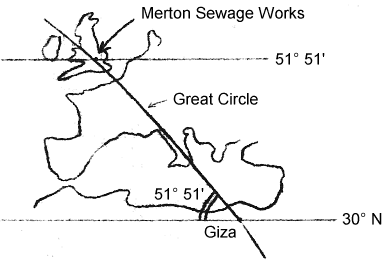
A great circle through the Great Pyramid, oriented towards W 51° 51′ N, crosses the 51° 51′ N parallel at Merton Sewage Works (longitude 1° 9′ W of Greenwich). The Earth assumed to be a sphere.
2. In the pyramid folio Mr Greenwood points out that:
| Latitude of Meidum | = | Latitude of Avebury |
| Latitude of Avebury | 90° |
Using stars instead of Ancient Monuments and declinations (epoch 1950) instead of latitudes I give:
| Declination of Sirius | = | Declination of Vega |
| Declination of Vega | 90° |
1. Height × 1010 = mean distance of Saturn from the Sun.
2. Base × 1.75 × 106 = radius of Satellite IV’s orbit about Saturn.
3. Base × 6 × 107 = radius of Satellite IX’s orbit about Saturn.
| 4. | Displacement of Entrance from central N–S axis | ≈ Eccentricity of Saturn’s orbit about the Sun. |
| Base |
5.
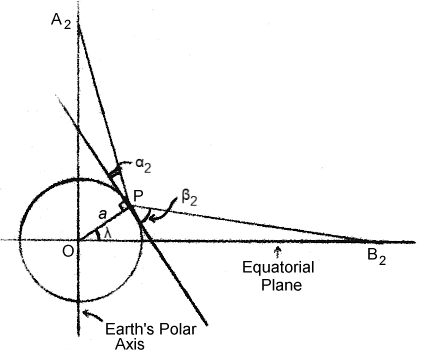
Let P be a pyramid latitude λ (Earth assumed spherical) with face-slope angle β2, (north facing) passage angle α2.
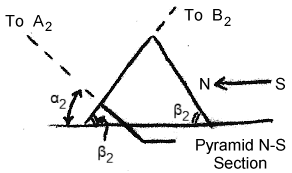
If a is the radius of the earth (6378 km) then
| OB2 | = | a(cosλ + sinλ tan(λ + β2)) | |
| and | OA2 | = | a(sinλ + cosλ cot(λ − α2)) |
Taking λ = 29° 59′, β2 = 52° 20′ (Edwards) for Chephren’s Pyramid the result
| 2 × OB ≈ Radius of Saturn (i.e. equatorial radius) emerges, |
6. Chephren’s Pyramid has two entrance passages, the upper with α1 = 25° 55′ and the lower with α2 = 21° 40′. These give OA1 = 80,890 km, OA2 = 40,980 km. from which
| A1A2 ≈ 1/3 diameter (equatorial) of Saturn. |
1. Using Edwards (p. 151) original height of 471 feet error is 0.6% on BAABritish Astronomical Association Handbook figure for mean distance of Saturn from the Sun.
2. and 3. Base is 707¾ feet. Errors compared with BAA H’book are, for (2) 0.004%, for (3) 0.07%.
4. Edwards (p. 152) gives displacement as “about 41 feet”. 41/707.75 = 0.05793 as opposed to eSaturn = 0.0556263 (BAA H’book) – 4.1%. A relatively ‘poor’ result as it stands.
5. With λ = 29° 59′, β2 = 52° 20′, a = 6378 km then 2OB = 58300 km, an error of 2.3% on BAA H’book figure.
6. With figures given A1A2 = 39,910 km, a 0.4% error on BAA H’book figure.
Still for Chephren’s Pyramid:
a) Base × 109 = Diameter of orbit of Venus about Sun (0.3%)
b) 2 × Height × 1010 = Mean distance of Uranus from Sun (0.05%)
| c) | Entrance Displacement | ≈ Oblateness of Jupiter (2.4%) |
| Base |
d) 2 × OB × 1000 ≈ Mean distance of Mercury from Sun (0.7%)
1. The Andromeda Nebula, in 1950, had declination +41° 0′ (Norton’s Star Atlas). Precession has increased its declination by some 3′.3 per decade, so that in 1971 its declination would have been +41° 7′. This angle is defined by the Pythagoran triangle shown here (732 = 482 + 552).

55 is a Fibonacci number
48 is a product of three Fibonacci numbers (2 × 3 × 8).
73 is a sum of three Fibonacci numbers (5 + 13 + 55).
The generators* of this triangle are u = 8, v = 3, both Fibonacci numbers.
2. The Dumb Bell Nebula in the constellation of Vulpecula had (in 1950) a declination 22° 35′, which is close to the smaller angle of a 5:12:13 Pythagorean triangle.

The numbers 5 and 13 are both Fibonacci numbers.
The generators* of this triangle (u = 3 and v = 2) are also Fibonacci.
*Note Pythagorean Triangles can be generated by two numbers u and v by constructing the triangle with sides u2 − v2
3. Budge-Budge in West Bengal, India, has, according to the index of The Times Atlas Vol. 2, a latitude of 22° 29′. This angle is the smallest angle of an interesting triangle, even though it is not Pythagorean.
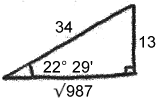
13 and 34 are both Fibonacci numbers.
√987 is not a whole number, but 987 is a Fibonacci number*.
Also √987 = 10 × π to an accuracy of 1 part in 50,000, so that whether it knows it or not,
Budge-Budge is linked with the Fibonacci Sequence, the Golden Mean
(sin 22° 29′ = φ−2 with 0.1% accuracy)
and the Squaring of the Circle.
Kowloon City – Hong Kong, latitude 22° 27′ (Times Atlas Vol. 1), has similar properties.

21 and 55 are Fibonacci; 2584 is Fibonacci.
√2584 = 10 × π × φ (accuracy 0.002%).
sin 22° 29′ = φ−2 (accuracy 0.02%).
* Note A right-angled triangle can have at most two of its sides Fibonacci numbers. In case 3, given the 13 and 34 it may come as a surprise to the non-mathematician that 987 is also Fibonacci. This is a property of next-but-one terms of the Fibonacci Sequence, for denoting the nth term of the sequence by un, it can be shown that un+22 − un2 = u2(n+1). (Here u1 = 1, u2 = 1, u3 = 2, etc.) 13 and 34 are alternate terms, hence the difference of their squares will be a Fibonacci number. Similarly for 21 and 55 in case 4. It can also be shown that the appearance of π in the above arises from the realtionship φ2 ≈ 5π/6.
5. Mr Ivimy claims (p. 132 of his xerox) that Megalithic Yard : Royal Cubit as √5 : √2. I have pointed out in my Numerical Coincidences (sec. 11) that 1 km : 1 mile as 5 : 8, both these simple digits being Fibonacci numbers.